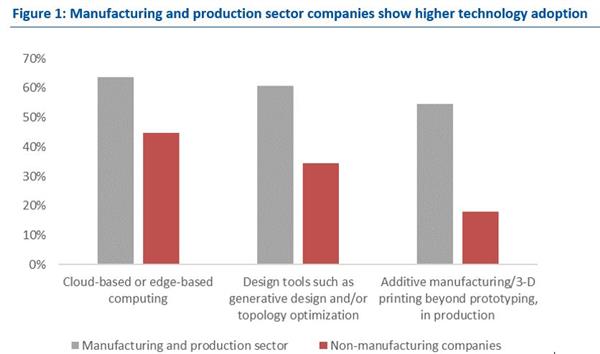Manufacturers Use Agile and Intelligent PLM to Reduce Time to Market
This research brief examines how companies in the manufacturing sector align their business strategies to meet pressures and goals such as reduced time to market through the use of intelligent technologies such as generative design, topology optimization, additive manufacturing, and a combination of edge and cloud computing.
The most recent SAPinsider survey shows that more than half of manufacturing sector respondents (versus a minority of non-manufacturing companies) use generative design or topology optimization, additive manufacturing, and a combination and edge and cloud computing to process data and manage products (see Figure 1).

Manufacturing companies have used additive manufacturing, commonly known as 3D printing, for prototypes for decades, but recent years have seen a boom in using more advanced and faster additive technologies for customized and replacement parts in production environments. Customized parts can add an element of complexity to product management, but additive manufacturing makes it possible. Manufacturers can use adaptable designs and only need the ability to source the appropriate powders or raw materials for the 3D printers and the ERP system to track orders from placement to delivery.
Additive manufacturing also has strong ties to the adoption of design tools such as generative design or topology optimization because 3D printers have much wider ranges of design freedom than more traditional molding and casting or CNC reductive manufacturing and these design tools create very unique shapes. According to the data, it appears most manufacturing companies now at least use topology optimization to speed up the design process and design lighter weight, cheaper products that use fewer materials but still fulfill or exceed performance requirements. This helps meet their driver of faster, better, cheaper products.
Meanwhile, the use of cloud and edge-based computing technology can help manufacturers create digital twins that process manufacturing or performance data at the source and synchronize it with product data in the cloud to monitor and manage both manufacturing processes and products in the field while feeding back performance data to improve future designs.
The full research brief explains the ways in which companies from the manufacturing sector utilize these technologies and aspects of agile and intelligent PLM to meet their business needs, and how their practices differ from survey participants in other economic sectors and industries.






